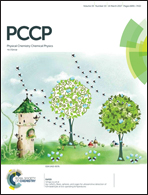Adsorption behaviors and vibrational spectra of hydrogen peroxide molecules at quartz/water interfaces
Abstract
The effect of H2O2 concentration on the change of H-bonds at a water/quartz interface was systematically examined by surface-specific sum-frequency generation (SFG) spectroscopy. Molecular dynamics (MD) simulation was further utilized to interpret the specific molecular dynamics as well as the configuration and evolution of water and H2O2 molecules at the interface. The results from this study demonstrated the important role of surface H-bonds on determination of the stability of adsorbed H2O2 at solvated, silica, xerogel surfaces. It was revealed that prior to reaching the surface saturation with H2O2 molecules (less than 20% in bulk solution), multiple H-bonds were formed with silanols at relatively short interactive distances. These H-bonds proved to be strong enough to enable the overall stability of adsorbed H2O2. However, once saturated, the H2O2 molecules would be adsorbed at longer distances away from the surface, and could easily migrate to the bulk solution; therefore, in this case, the bonds failed to support stable H2O2 adsorption. These new findings explained the detailed molecular mechanism of the relationship between H2O2 concentration and H2O2 stability in H2O2–silica xerogels. This solves the current challenge of effective H2O2 storage, and provides fundamental insight for predicting the adsorption behavior of H2O2 at the silica surface.



 Please wait while we load your content...
Please wait while we load your content...